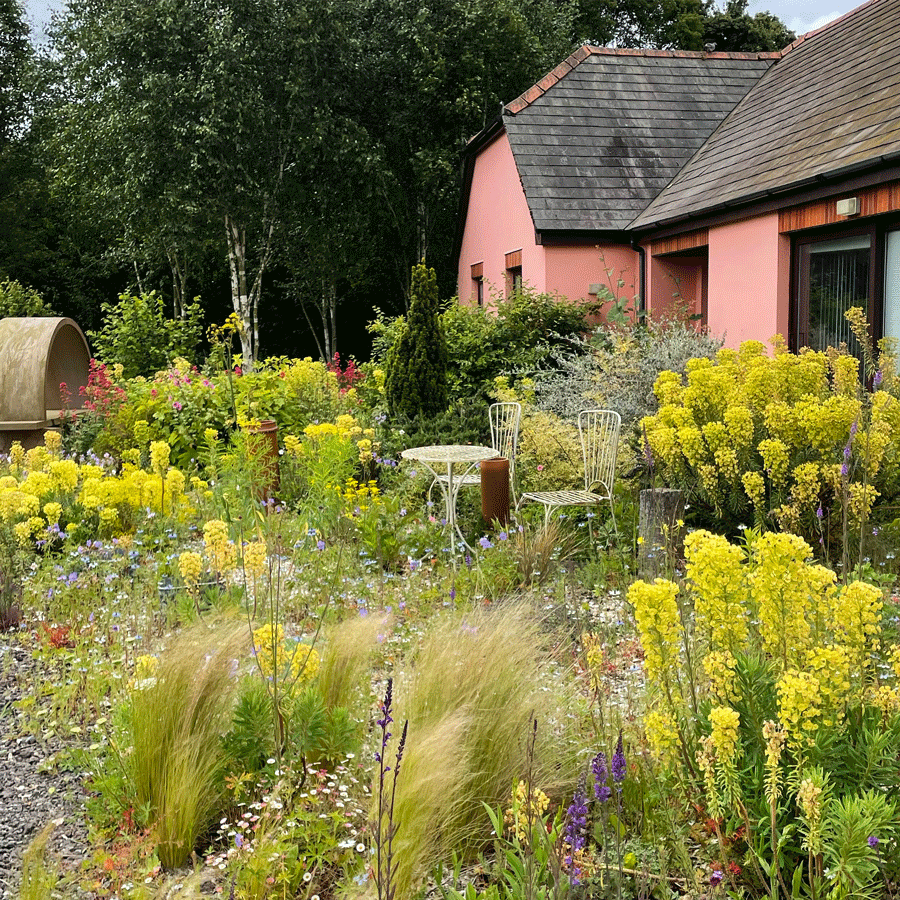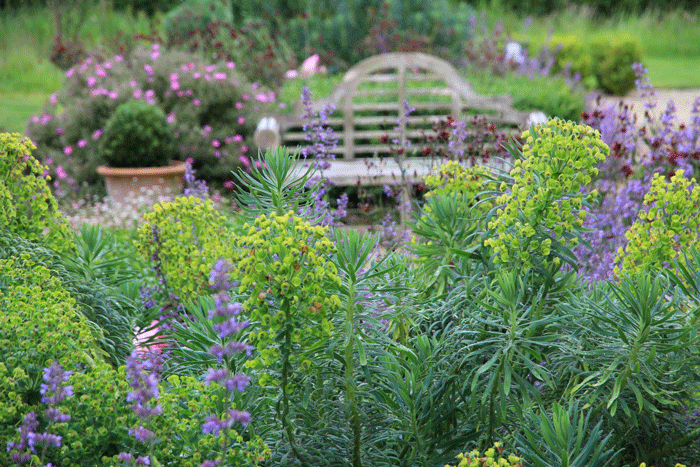Garden Design trends 2023
Every year members of The Society of Garden Designers (SGD) publish their garden trends for the coming year. For 2023, the environment is still centre stage with everything from Rock Roses to Twisted Geometry among the styles, materials and patterns to look out for. Sit comfortably, grab a coffee and take a look:
Environmentally Healthy Gardens
Sustainable and eco-friendly gardens are nothing new, but as we begin to gain a better understanding of what this actually means, we start seeing the creation of gardens that are, ‘environmentally friendly to the core and not just as a style trend’ according to garden designer, Tomoko Kawauchi MSGD: “We need to enter the next phase of the movement” she says.
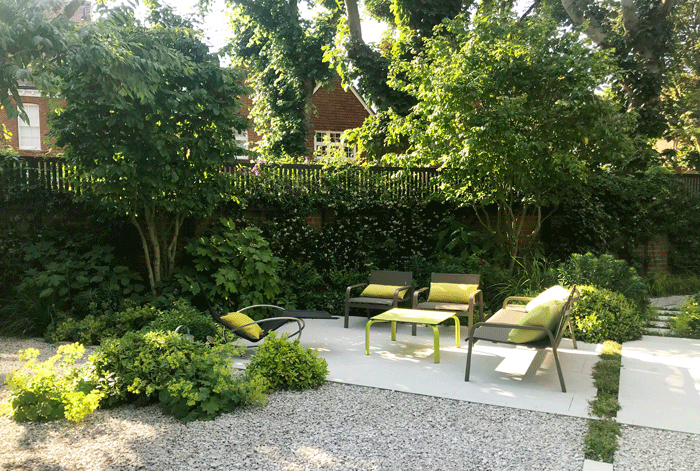 (above) Garden by Tomoko Kawauchi at Charlotte Rowe Garden Design
(above) Garden by Tomoko Kawauchi at Charlotte Rowe Garden Design
Tommaso del Buono MSGD, points out that less emphasis on the naturalist ‘rewilded’ approach seen at last year’s RHS Chelsea and a return to a more structured style that relies on, “interplay between man-managed forms and nature“, will feature.
Helen Elks-Smith FSGD agrees that wildlife and insects don’t need gardens and landscapes to have a particular design aesthetic: “They don’t care whether a garden looks ‘wild’ or whether it looks ‘formal’ – what matters is habitat, food sources and shelter.” Helen points out that creating a wild garden or trying to recreate a native environment is just one approach – there are others and it’s important that different approaches and design are encouraged and allowed.
Eco-friendly interventions
There are things that can be done to create more sustainable gardens that will impact how our gardens look.
Tina James MSGD notes that greenhouses and kitchen gardens are having a surge in popularity as people become more interested in growing their own food. Andrew Duff MSGD, Co-Chair of the Society, goes one step further and suggests we will see: “… a much-welcomed return to the original cottage garden, remodelled for 2023, where function and aesthetics work as one and where sustainability isn’t a choice. A garden where seasonality and change is embraced rather than masked – a working garden.”
Rachel Bailey MSGD says she would like to see gardens paved less and planted more while Andrew also foresees a movement against artificial grass – amen to that we all say. Matthew Childs MSGD, thinks we will be paying much more attention to mulches and says he will be using recycled building materials such as crushed concrete, as well as fruit pits and nut shells to form natural mulches and path surfaces.
There is no doubt that the trend for recycled materials will continue with designers such as Tomoko Kawauchi exploring ways of using recycled materials in contemporary spaces including cutting existing paving into narrow strips to create new terraces and paths.
Natural Swimming pools and ponds
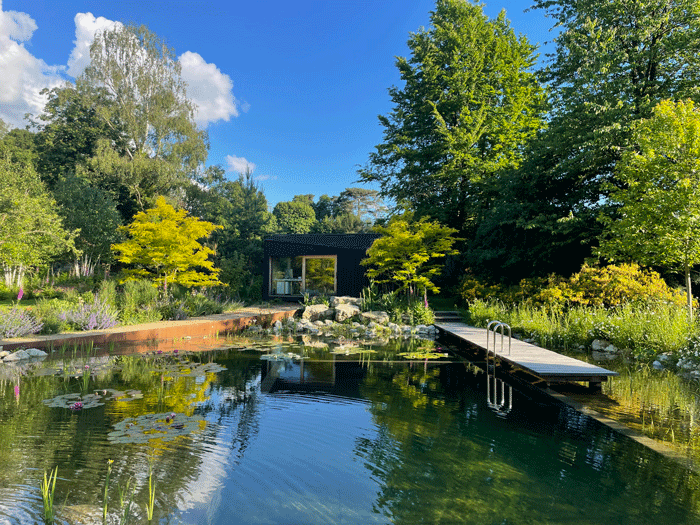 (above) Natural Swimming Pool by Matthew Childs
(above) Natural Swimming Pool by Matthew Childs
Matthew believes that as we move into 2023 we will see a trend for gardens to be joyful, fun spaces where people, plants and wildlife can be mutually beneficial to each other. He points out that a good example of this is the growth of chemical free, natural swimming ponds. Helen is seeing considerably more interest in natural swimming pools for 2023, while Jamie Innes MSGD is expecting to see more water features and ponds.
Drought-tolerant plants
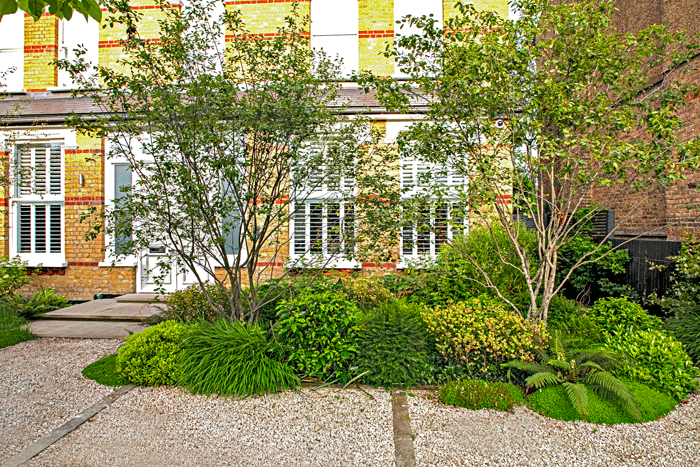 (above) Gravel Garden by Tomoko Kawauchi: Image: James Kerr
(above) Gravel Garden by Tomoko Kawauchi: Image: James Kerr
Hot summers and unpredictable rainfall patterns are becoming more familiar and with that comes a trend towards tougher, more resilient plant palettes. Matthew sees plants that provide year-round colour and interest and which create joy in the garden will still be central to his designs but he will also be looking for resilient plants, such as long-flowering Salvias, that are great for pollinating insects and wildlife. Tina James is also experimenting with Salvias, blending them with swathes of grasses to create energy and movement.
The trend for more trees, especially in city gardens, is increasing and Marian Boswall MSGD hopes to this this, especially where they can: “..help clean the air and reduce the urban heat effect”. She recommends the drought-tolerant crab apple tree as a perfect addition to any garden: “It’s blossom feeds insects in spring and in the depths of winter, when the ground is covered in snow and there is little to eat, its tiny apples providing nourishment for birds,” she says.
Tomasso expects Rock Roses to come back into fashion because of their ability to thrive in hot, dry conditions. These low-maintenance plants are fast-growing with a profusion of flowers and the ability to grow over walls, paths and rockeries as well as in mixed borders.
Darker shades with pops of colour
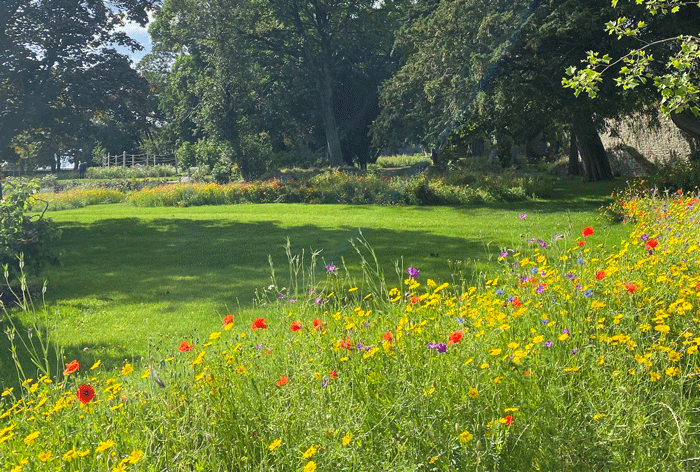 (above) Garden by Tommaso del Buono
(above) Garden by Tommaso del Buono
Colours that look big in the garden, although not led by environmental factors, are likely to be darker hues of blues, purples and greys, combined with small bursts of brighter colours. Helen Elks-Smith says she will be using smokey hues and purpoles as well as soft greys and greens, while Tommaso del Buono sees a move towards dark foliage, like the deep brown leaves of Anthriscus ‘Ravenswing’ alongside rich, dark flowers such as the deep purple Aquilegia ‘Black Barlow’.
Tommaso is also experimenting with injections of colour such as vivid pinks including the giant tree dahlia ‘Dahlia imperialis’ as well as various species of Nerines. Matthew recommends annuals and species bulbs to ensure there is a pop of colour in the garden all year round.
Twisted geometry
Materials will be taking on a darker shade too as Tommaso points out. An increased popularity in darker natural stones, heavier hues for paving and other hard landscaping to add depth to his designs and create a dramatic foil for greenery. Helen sees a leaning towards warmer brown and buff colours, influenced by the popularity in interior design of brass and copper fittings.
Pattern is also on the rise and Tommaso expects we will be seeking to make the whole more interesting and intriguing by using off-kilter symmetry and experimenting with proportions and perspective.
Smart design
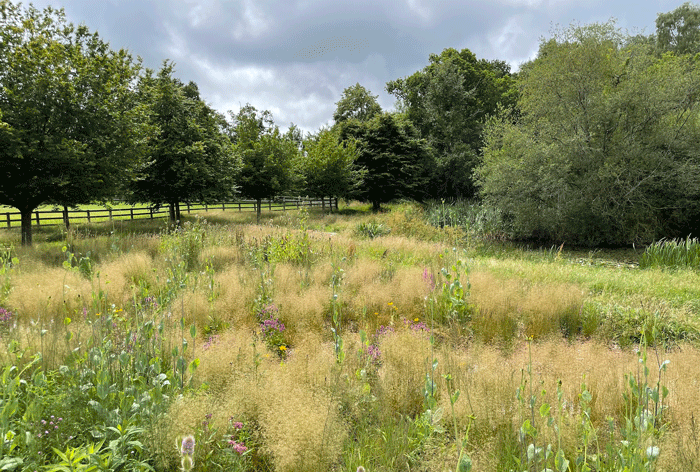 (above) Garden by Helen Elks-Smith
(above) Garden by Helen Elks-Smith
Summing up the trends, in general terms, the big trend for 2023 is about thoughtful, clever design. As Helen puts it: “Garden design will become smarter, incorporating the changes that are necessary to protect the planet.” Lorenzo Soprani Volpini MSGD and Ana Marie Bull MSGD, agree and believe we will start seeing small adjustments that make the process more eco-friendly. Their approach is to consider the carbon footprint of every product of plant, as well as using local materials where possible.
The rise of innovative design including things such as ground source heat pumps and solar panels is hinted at by Matthew Childs as well as charging points for electric cars.
Helen wants to see a move away from heavily hardscaped gardens to more of the important green stuff, a sentiment that Tina James agrees with: “I think as we are all becoming more environmentally conscious the ‘less is more’ approach is the way to go when it comes to hard landscaping. I design terraces that are large enough and function well for the home without being too large. Large slabs with gravel between instead of pointing ensures good drainage, uses less stone overall and looks beautiful especially with edges softened by graceful planting,” she says.
Summing up, Andrew Duff welcomes the need to immerse ourselves in the great outdoors, whether it is an open window across balcony planting, our own gardens, park, or the joyous countryside: “Surrounded by artificiality at every level we seek real grass to feel beneath our feet, misshapen fruit to pick from a tree and the memory inducing power of scent. Our gardens will have to work harder than ever to meet these primeval needs,” he says.
The Society of Garden Designers provides access to garden designers right across the UK. Their comprehensive Find a Designer search facility on the SGD website allows you to search by name, postcode, county or country. For more information on the SGD please visit their website: www.sgd.org.uk
All images are strictly © of garden designer and credited to photographer where noted. Banner feature top of page; Garden gravel & drought-tolerant plants in Rosy Hardy’s Garden: Image by Matthew Childs

